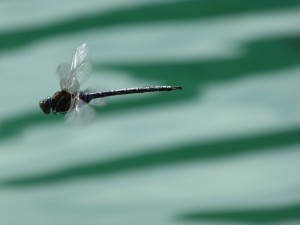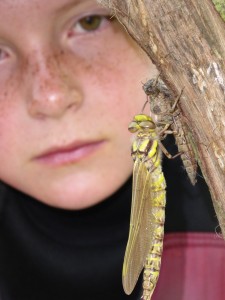Did you know the New Forest is one of the best places in the UK to spot a dragonfly? Of the 36 species which exist in this county, an amazing 74% of them can be found here. June and early July is the wonderful time to observe dragonflies as they emerge from their larval cases and exchange a life in water for one of flying. So with streams, rivers, ponds and wet bogs aplenty to explore follow these tips to observe and learn about their incredible lives.
Emerging from the depths:
Pond dipping is a ‘must’ to discover the secret and watery world of dragonfly larvae. There are three stages in the life-cycle of all dragonflies. The egg hatches into the larva (also known as a nymph), which moults up to 15 times before emerging as an adult. Easy to catch using a pond net, the nymphs are best observed in a collection tray where they can freely move around. As an ambush predator and well camouflaged it’s easy to see how they can tackle prey such as small fish and tadpoles.
Look for exuvia, the larval skin left hanging on the stems of vegetation, often just a few inches above the water level. It’s best to collect dry moulted skins still attached to plant stems to hold and study up close, as the skins are very delicate to handle. Children are fascinated with these alien-like skins – point out the hole in the thorax just behind the eyes where the adult dragonfly has pushed itself out.
Early morning on a warm, dry day is a good time to look for newly emerged adults. If you’re lucky you’ll be able to watch how the soft, wrinkled wings and tail (abdomen) expand and harden as body fluids are pumped around its body. This helps to explain why the adult looks much bigger than its shed larval skin – a fact children often point out and find amazing! This transformation can take 2-3 hours.
Fishing for dragons:
Find a quiet ‘sit spot’ alongside the edge of a pond and hold out a long twig. Male dragonflies are very territorial and if you keep still they might perch on your twig to check you out. With ‘huge’ eyes and 360 degree vision, they are able to see in front, to the side and behind all at the same time!
Get snappy:
As the fastest and most acrobatic of flying insects, dragonflies can fly forwards, sideways, backwards and hover. This makes them skillful hunters that can chase their insect food down in flight. A fun challenge is to photograph this action using a sports action setting on auto-focus to allow you to concentrate on your stealth skills.

Dragonfly hunting: Don’t identify dragonflies on warm sunny days. Like other insects they are cold blooded, and rely on warm air to help raise their body temperature high enough to fly, so it’s easier to study them at rest in the early morning, often with dew covered wings, before the hottest part of the day. Use close-focusing binoculars and a good field guide – A guide to the Dragonflies of Great Britain written and illustrated by Dan Powell, a New Forest based artist, is particularly good.
Happy hunting!

